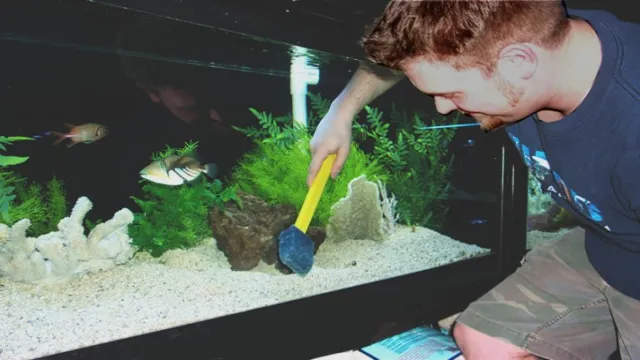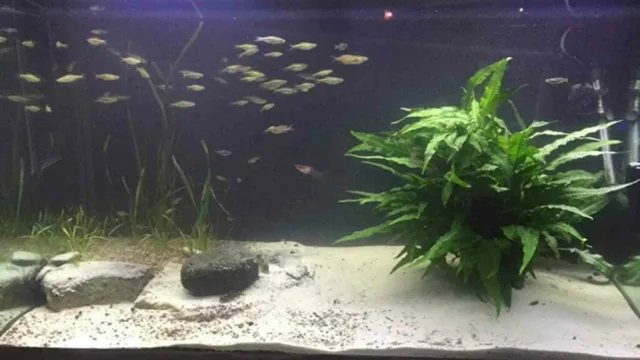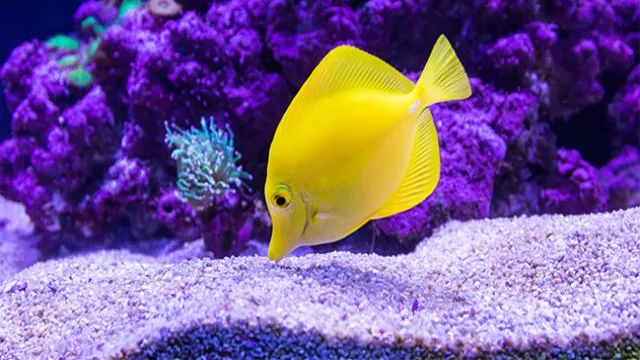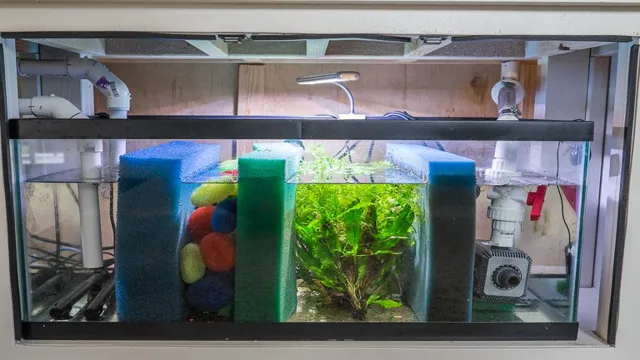If you’re a proud fish owner, you know that the key to keeping your aquatic pets happy and healthy is ensuring their environment is consistently clean. A clean aquarium not only looks better, but it also promotes better health for your fish, plants, and other living creatures. However, keeping an aquarium clean can be a daunting task, especially for beginners.
But fear not! We’re here to give you a step-by-step guide on how to clean your aquarium like a pro. Whether you have a saltwater or freshwater aquarium, a nano or a giant tank, we’ve got you covered. Keep reading to discover how to keep your aquatic ecosystem in pristine condition.
Gather Supplies
When it comes to cleaning your aquarium, it’s important to gather all the necessary supplies before starting. This will not only save you time but also ensure you have everything you need to clean your tank effectively. Some basic supplies you’ll need include a gravel vacuum, a bucket, a sponge or scraper for cleaning the glass, a water conditioner, and a fish net.
If you have live plants, you’ll also need scissors or pruning shears to trim them. It’s also important to use a specific cleaning solution that’s made specifically for aquariums. Don’t use regular cleaning products, as they can be harmful to your fish.
Once you have all your supplies, you can begin the cleaning process and ensure a healthier living environment for your aquatic pets. Remember to take your time and be gentle, as you don’t want to harm any of your fish or plants in the process. So, gather all the supplies and start the cleaning process using the best instruction for how to aquarium clean.
Bucket, algae scraper, sponge, vinegar
When it comes to cleaning your aquarium, having the right tools can make all the difference. To get started, you’ll want to gather some basic supplies, including a bucket, algae scraper, sponge, and vinegar. The bucket is essential for removing water and debris from the tank.
You can use the algae scraper to remove any stubborn algae buildup on the glass or decorations. A sponge is great for wiping down the inside of the tank and removing any excess algae or debris. Finally, vinegar can be used to clean the tank without harming your fish.
All you need to do is mix one part vinegar with five parts water and wipe down the tank. Once you have all of your supplies, you can begin cleaning your aquarium like a pro. With a little bit of elbow grease and the right tools, your fish will be swimming in a sparkling clean tank in no time.
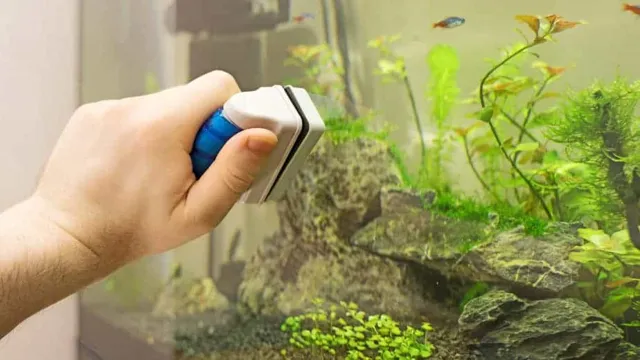
Remove Debris
If you want to maintain a healthy, thriving aquarium, regular cleaning is an essential factor. One of the most basic yet critical aspects of aquarium cleaning is removing debris. Debris, such as uneaten food, fish waste, and dead plant matter, can lead to poor water quality, which can potentially harm your fish.
A good way to remove debris is by using a gravel vacuum, which allows you to suck the debris out of the substrate without disturbing your fish too much. You can also use a simple fish net to remove larger debris floating around the tank. Another crucial aspect to keep in mind when removing debris is to avoid overfeeding your fish or adding too many plants to the tank.
The more fish and plants you have, the more debris they will produce, making it more challenging to maintain a clean and healthy environment. By following these simple steps, you can keep your aquarium clean and your fish happy and healthy. Remember, a clean aquarium is a happy aquarium!
Remove uneaten food, dead plant matter
When it comes to maintaining a healthy and attractive aquarium, one essential task is the removal of uneaten food and dead plant matter. This debris not only detracts from the appearance of your tank but can also negatively impact water quality and harm your fish. It’s important to regularly check for and remove any leftover food or dead plants, as they can quickly begin to decompose and release harmful chemicals into the water.
Not only does this put your fish at risk, but it can also lead to the growth of harmful bacteria and algae. So, make sure to skim the water’s surface with a net to remove any floating debris and use a gravel vacuum to clean the substrate and remove any waste or debris that has settled there. By taking these simple steps regularly, you can help ensure a clean and healthy environment for your aquatic pets.
Empty Water
Maintaining a clean and healthy aquarium is essential for the well-being of your aquatic pets. One of the common issues encountered by many aquarium owners is the problem of empty water. This is when the water in your tank starts to disappear, leaving your aquarium half-full. (See Also: How to Make Aquarium Bonsai: A Step-by-Step Guide for Stunning Underwater Landscapes)
Although it may seem like a minor issue, it could lead to the death of your fish if left unaddressed. So, how do you clean an aquarium that is constantly losing water? Firstly, you need to identify the source of the problem. Check all the equipment, including the filter, heater, and airstones, for any leaks or damage.
If you find any issues, take immediate action to fix them. Secondly, determine if evaporation is the culprit. If you’re losing water due to evaporation, adjust your water level accordingly and cover the tank to reduce water loss.
Lastly, keep an eye on your aquarium and conduct regular water tests to ensure your aquatic pets are living in a safe and healthy environment. With these tips, you can keep your aquarium clean and your fish happy and healthy.
Take out 10-15% of water every week
One of the most essential aspects of maintaining a healthy and thriving aquarium is regular water changes. Every week, we recommend taking out 10-15% of the water in your tank to keep it clean and free of harmful toxins. This process requires careful attention and precision to ensure that it is done correctly.
Begin by turning off all electrical equipment and scooping out any debris or uneaten food. Then, using an aquarium siphon, empty the desired amount of water into a bucket. It’s essential to make sure that new water is added, which should always match the temperature and pH of the existing water.
By doing this, you’ll maintain a stable and healthy environment for your aquatic friends to live in. Remember, regular water changes aren’t just beneficial for your fish and plants; they’re also essential for reducing the risk of disease and algae growth in your tank. So, get into the habit of doing a weekly water change to keep your aquarium healthy and beautiful!
Clean Decorations
One of the keys to maintaining a healthy and attractive aquarium is to regularly clean the decorations. This not only keeps the water quality in check, but it also helps to eliminate any potentially harmful bacteria or algae growth. Start by removing all of the ornaments from the tank and scrubbing them with hot water and a non-toxic cleaner, such as vinegar or baking soda.
Be sure to rinse the decorations thoroughly and allow them to air dry completely before placing them back in the tank. It’s important to avoid using harsh chemicals or abrasive tools that could scratch or damage the surfaces. By incorporating this simple cleaning routine into your aquarium maintenance regimen, you can help ensure that your fish and aquatic plants thrive in a clean and healthy environment.
Remove and scrub decorations with sponge
When it comes to cleaning decorations, it’s important to take the proper steps to ensure they come out looking their best. For starters, remove any decorations from their holders or strings and place them in a sink or tub. From there, use a sponge with warm water and gentle soap to scrub away any dirt or grime.
If there are any stubborn stains, consider using a mixture of baking soda and water to create a paste, and use a toothbrush to gently scrub away the stain. Rinse off the decorations with clean water and lay them out to dry on a clean towel. By taking the time to properly clean your decorations, you’ll be able to enjoy them for years to come.
Clean Glass
If you’re a fish enthusiast, you know how important it is to keep your aquarium clean. A clean aquarium means happier fish and a clearer view of your underwater world, and nothing helps achieve that clearer view quite like clean glass. There are a few steps you can take to make sure your glass stays sparkling.
First, make sure you have the right tools – a scraper, a sponge, and a microfiber cloth should do the trick. Next, turn off any electrical equipment and carefully remove any plants or decorations that may be in the way. Using the scraper, gently remove any algae or debris from the glass.
Then, use the sponge to wipe down the glass and remove any remaining residue. Finally, use the microfiber cloth to dry the glass to prevent any water spots from forming. With these simple steps, you’ll have crystal-clear aquarium glass in no time.
Scrape algae off with scraper, vinegar for stubborn stains
Glass aquariums are beautiful to look at, but they require some maintenance to keep them sparkling clean. One of the most important tasks in maintaining a glass aquarium is to remove algae from the glass surface. For this, you can use a scraper that is specifically designed for glass aquariums. (See Also: How to Clean Aquarium Glass Water Stains: Simple Tips and Tricks)
Scrape off the algae gently, making sure not to scratch the glass. For stubborn stains that don’t come off with just scraping, you can use vinegar. Mix equal parts of water and vinegar in a spray bottle and spray it on the stubborn stains.
Let it sit for a few minutes and then use the scraper again to remove the algae. It’s important to clean the glass regularly, as algae can affect the water quality of the aquarium. With this simple cleaning routine, you can enjoy a clear and beautiful view of your aquarium.
So, go ahead and give it a try!
Add New Water
If you’re wondering how to clean your aquarium, the process can be fairly simple and straightforward, as long as you know what you’re doing. One of the most important steps in this process is adding new water to your tank. Before you do this, you’ll want to make sure you’ve removed any debris or waste from the tank and conducted a water change.
Once you’re ready to add new water, make sure it’s at the appropriate temperature and has been treated with a water conditioner to remove any harmful chlorine or other chemicals that could harm your fish. Slowly pour the water into the tank, being careful not to disturb the substrate or decorations too much. If you’re using tap water, it’s always a good idea to test the water quality afterward to make sure it’s safe and balanced.
With these simple steps, your aquarium will be clean and your fish happy and healthy.
Gradually add water that is the same temperature as the tank
When it comes to aquarium maintenance, adding new water to the tank can be a bit tricky. You don’t want to shock your fish by adding water that is too cold or too hot, so it’s important to gradually add water that is the same temperature as the tank. This will help acclimate your fish to the new water and prevent any potentially harmful fluctuations in temperature.
While adding water, it’s important to keep an eye on the water level to ensure you’re not overfilling the tank. Remember, too much water can cause stress and harm to your fish. Using a thermometer to check the temperature of the new water can be helpful in ensuring it matches the current water temperature.
By taking the time to properly add new water, you can ensure a healthy and happy environment for your aquatic friends.
Cycle Tank
Cleaning your aquarium is essential to maintaining a healthy environment for your fish and aquatic plants. One of the best ways to keep your aquarium clean is to cycle the tank regularly. Cycling involves establishing a colony of beneficial bacteria that will break down the waste produced by your fish.
One way to cycle your tank is to add a small amount of food to the tank and let it decompose for a few days. The bacteria will begin to grow and multiply, and you can test the ammonia and nitrite levels in the water to determine when the cycle is complete. Another method is to use a commercial product that contains live bacteria, which can speed up the process.
Regardless of the method you choose, make sure to monitor the ammonia, nitrite, and nitrate levels in the water to ensure a healthy environment for your aquatic pets. By following these tips and regularly cycling your tank, you can keep your aquarium clean and healthy for years to come.
Wait a few hours before reintroducing fish
If you’re a beginner in fishkeeping, one of the first things you need to learn is the process of cycling a tank. Cycling a tank involves establishing the right balance of beneficial bacteria in your aquarium to break down harmful substances from fish waste and uneaten food. Before adding any fish to your tank, it’s crucial to wait a few hours to ensure that the balance of your water parameters holds steady, especially if you’ve just finished adding the bacteria. (See Also: How to Make Fish Aquarium Model: Step-by-Step Guide for Beginners)
This way, you can avoid any sudden fluctuations in pH, ammonia, and nitrite that could stress or harm your new fish. It’s always best to go slow and take your time in fishkeeping to ensure a healthy and thriving aquatic environment for all your aquatic pets.
Conclusion
In conclusion, cleaning an aquarium can seem like a daunting task, but with the right tools and procedures, it can be a breeze. Treat your aquatic friends like the royalty they are by performing regular water changes, scrubbing algae, and vacuuming debris. Remember, a clean aquarium not only promotes healthy fish and plants, but also makes for a visually stunning centerpiece in your home.
So, grab your gloves, put on some tunes, and get ready to dive into the world of aquarium cleaning – your fish will thank you for it!”
FAQs
How often should I clean my aquarium?
It is recommended to clean your aquarium once a week to maintain a healthy environment for your fish.
What supplies do I need to clean my aquarium?
You will need a sponge or scraper for the glass, an algae scraper or magnet for the walls, a siphon hose for gravel cleaning, and a clean bucket for water changes.
Can I use soap to clean my aquarium?
No, you should never use soap or any other cleaning agents that are not specifically designed for aquarium use. Soap residue can be deadly to your fish.
Should I remove my fish during cleaning?
It is recommended to remove your fish during deep cleaning like changing gravel or during major tank rearrangements. But during a normal weekly aquarium cleaning, fish can stay in the tank.
How do I clean the filter of my aquarium?
You can clean the filter by taking apart and rinsing the filter media gently in aquarium water. Be sure to rinse it thoroughly, as buildup in the filter can be harmful to your fish.
How much water should I change during cleaning?
You should change 20-30% of the water in your aquarium every week to remove excess nutrients and keep your fish healthy.
How do I test the water quality of my aquarium?
You can test the water quality using a water testing kit. These kits can measure pH, ammonia, nitrite, and nitrate levels, which will help determine if your aquarium is healthy for your fish.

